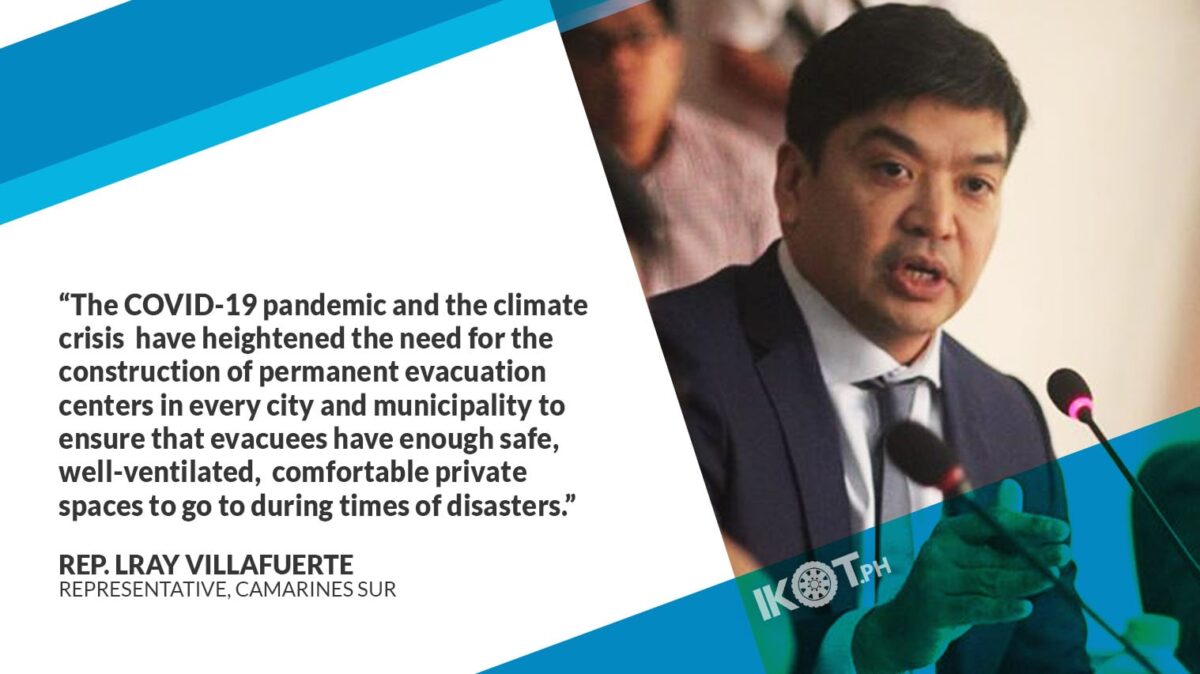Camarines Sur Representative LRay Villafuerte has underscored anew the urgency of building permanent evacuation centers in disaster-prone areas following the triple onslaught that his home province and other Bicol provinces from the recent string of strong typhoons that struck the country.
Villafuerte said Camarines Sur and the rest of Bicol had suffered massive destruction and flooding from three tropical cyclones—Quinta, Rolly and Ulysses—that hit the country in a span of just two weeks.
“Such a plan should top the concerns of the would-be Department of Disaster Resilience (DDR), so the government could best achieve its zero-casualty goal.”
Villafuerte, who was former Camarines Sur governor and now represents its second district in the House of Representatives, has been calling for the construction of permanent evacuation centers for calamity victims as early as two years ago, following the devastation wrought in Luzon in September 2018 by Super Typhoon Ompong, which killed at least 65 people and sent over 100,000 people fleeing to evacuation sites.
He reiterated his call when 50,000 residents of Cavite and Batangas were forced to flee their homes when Taal volcano erupted earlier this year. At that time, President Rodrigo Duterte also bared his plan to build permanent evacuation centers for calamity victims.
“The COVID-19 pandemic and the climate crisis have heightened the need for the construction of permanent evacuation centers in every city and municipality to ensure that evacuees have enough safe, well-ventilated, comfortable private spaces to go to during times of disasters,” Villafuerte said.
He said the construction of these “climate-resilient” centers will also do away with the use of public schools as evacuation sites, a practice that has been strongly discouraged by the Department of Education (DepEd) as it disrupts classes until the evacuees are able to return to their homes.
Villafuerte said such a plan should top the concerns of the would-be Department of Disaster Resilience (DDR), so the government could best achieve its zero-casualty goal as this office and other concerned government agencies could fully implement preemptive evacuation, especially of people in coastal and mountainous communities.
“The construction of these ‘climate-resilient’ centers will also do away with the use of public schools as evacuation sites, a practice that has been strongly discouraged by the Department of Education (DepEd) as it disrupts classes until the evacuees are able to return to their homes.”
He co-authored the proposed DDR bill that the House passed in September this year.
Earlier, Villafuerte appealed to President Duterte and the Department of Budget and Management (DBM) to supplement the almost, if not completely, drained calamity funds of local government units (LGUs) in Camarines Sur and other provinces that bore the brunt of typhoons Ulysses, Rolly and Quinta.
Aside from Bicol, Villafuerte said calamity funds in the Southern Tagalog region and other areas in Luzon should also be augmented, as he called anew on the Congress to consider his proposal on setting aside a far bigger amount of calamity funds in the proposed 2021 General Appropriations Act (GAA).
He said “a lion’s share of his proposed bigger calamity budget in next year’s GAA should go to relief and rehabilitation work in Camarines Sur and the rest of Bicol along with the other places devastated by three successive typhoons in just two weeks’ time and the economic fallout from the prolonged pandemic.”
Villafuerte earlier filed a House resolution strongly urging the President to come up with a comprehensive Bicol rehabilitation program, in response to the heavy devastation by super typhoons, to include the provision of “immediate relief, recovery and reconstruction for rebuilding a better Bicol.”
In Camarines Sur, the Sangguniang Panlalawigan has passed Resolution No. 235 declaring a state of calamity for the province, to enable the provincial government to use available public funds for relief and other forms of assistance to typhoon-battered families.
“A considerable amount of time and effort is needed from the national government to get the devastated provinces back on their feet soon enough following the magnitude of destruction wrought by two of the most powerful storms to hit the country,” Villafuerte said.

